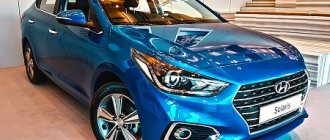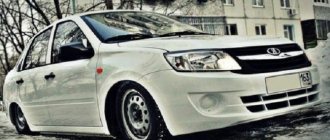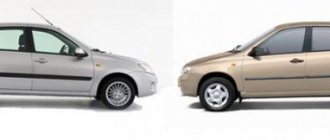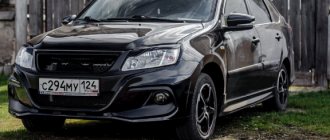Potential buyers and car owners are concerned with the question: does the Grant model have a galvanized body or not? The concern is easy to understand: the cost of the body is a significant part of the price of the budget car Lada Granta, galvanization protects the structure from the influence of adverse external factors.
Different sources provide conflicting information. Official representatives of the AvtoVAZ concern claim: the Lada Grant has a galvanized body, some sales dealers refute the statement.
How to care for an expensive car body, regardless of whether the body of the Lada Grant is galvanized or not?
Information from official representatives of AvtoVAZ
At the concern's factories, metal body elements are treated with a layer of galvanization. The low cost of the car does not allow covering the entire metal area; they protect the most vulnerable areas susceptible to corrosion:
• doors; • hind wings; • rear wheel niches; • luggage compartment lids; • body protective screen; • floor; • protective casing; • frame details; • rear wing groove.
The main vital structural elements are treated with a coating; the question can be removed whether the body of the Lada Grant is galvanized or not.
Features of car bodies
At first, AvtoVAZ marketers projected that the price of the new Lada Granta, which was released in 2012, would be several times lower than most domestic models. The cost was supposed to be no more than 220 thousand rubles, but fate was not destined to fulfill the promising hopes. As it turned out in reality, the production of even the most budget car had to meet modern quality and safety criteria. This includes a full power package, automatic transmission, air conditioning, and all this cannot be cheap.
Lada Granta all body types
If from an economic point of view it is difficult to determine the budget of the Lada Grant, then by the design of the body it is quite easy to do this. For some reason, the sedan received a rear end that in no way fits with the optics that resemble human eyebrows. The feeling of unfinished design and “dampness” scared off buyers. Fortunately, 3 years after the release of the budget sedan of the first series, AvtoVAZ assembled a liftback.
This is a completely different matter! Despite the structural relationship with the sedan, a quick glance at the liftback is enough for positive changes to become noticeable immediately. Again, the design became the main difference between these 2 modifications. If the sedan of the first series was made boringly and left the impression of a half-eaten pie, then the liftback now looks like a perfect and dynamic car, to match good foreign cars.
Lada Granta body types
In particular, the changes affected many things, despite the same budget class. The bumpers were unified as needed, according to the highest class: there were overlays made of unpainted plastic that organically fit into the design. They don’t look like something foreign and don’t make a repulsive impression, although based on the sedan’s experience this could be expected. The rear bumper with fog lamp is also good.
In general, the rear of a car is a separate matter. On the liftback, the work on the mistakes was carried out very competently. The repulsive brow ridges have disappeared, which now makes it possible to evaluate the optics in a completely different style: they even look much better than on Korean and Chinese budget-class liftbacks. The trunk door also turned out well, which no longer looks like a foreign body.
The rear part of the liftback, despite the absence of a wiper in the basic version, is carefully designed. Thus, VAZ designers promise that in the rain the rear window will be easily cleaned automatically by air flows, since they specially gave the glass the slope necessary for this. It is for this reason that the liftback in the standard version was deprived of the rear windshield wiper, but it is in the “Norma” and “Lux” versions, just in case, so to speak.
No offense to AvtoVAZ when they say that their new litfback looks so good that you forget that it belongs to this automaker. And this was only caused by corrections to design errors, which immediately affected sales. Potential clients instantly forgave AvtoVAZ for past mistakes and rushed to showrooms for a new liftback.
Body types of Lada Granta
The liftback also looks better than the sedan in profile. It looks better due to the sloping roofline and stylish rear doors, which the designers have successfully modernized. Today, many owners of 4-door sedans turn their heads thoughtfully, saying that if they had known in advance about the release of such an interesting 5-door new product, they would have delayed the purchase.
The rigidity of the liftback body has been carefully strengthened. As mentioned above, this was done for several reasons, one of which is the lack of proper reinforcement in the rear, following the sedan example.
Regarding body rigidity, the following work was carried out:
- Additional reinforcements were introduced into the design of the body base: brackets, braces, etc.;
- The thickness of the middle side members has been changed: now 1.8 mm, instead of the previous 1.5 mm;
- The thickness of the middle of the bottom has been changed: now 1.2 mm, instead of 0.95 mm.
Again, despite the measures taken, the rigidity of the liftback or hatchback body, as it suits you, gives way to the rigidity of the Grant sedan.
Note. By the way, many people ask why the Lada Granta is positioned in a new body type, as a liftback, and not as a hatchback. The fact is that the “niche” of hatchbacks is already occupied by its closest relative – the Lada Kalina, which is almost in every way similar in design to the Granta.
Regarding other elements:
- The rear view mirrors began to look more organically, fitting into the appearance of the car;
- The wheel rims have grown to 14 inches, which makes the car taller and allows you to forget that it is a budget car;
- The doors received limiters, which effectively affected the creaking. When you open the sedan door, you hear a nasty creak, but now it has disappeared, and when you close it, you can even hear the door closer operating;
- The liftback rear doors were equipped with new seals. Now, the half-lowered doors no longer rattle like on a sedan.
Note. The door locks, however, remain the same, but the manufacturer promises to install new ones, modified with the latest technology, from July.
- The “noise” of the body has been improved.
In the entire appearance of the liftback, only one thing is noticeable: VAZ engineers worked hard on this modification, trying to correct the obvious mistakes that irritated the owners of previous sedans. And, in particular, this also applies to sound insulation. The 5-door Granata is perceived as a quieter car than the Granta with a “traditional” body. The modification with automatic transmission is especially good in this regard, but the version with “mechanics” does not get rid of the characteristic “Grant” noise.
Regarding the dimensions of the new liftback:
- The length decreased by 13 mm, becoming equal to 4234 mm;
- The height is 1500 mm and the width is 1700 mm.
As for the curb weight, it is 1150 kg. This is slightly more than the weight of a sedan, but the extra door and other differences of the liftback are a clear reason for this.
The manufacturer was also pleased with the number of different colors and the quality of the materials used for painting. Now AvtoVAZ uses only high-quality materials that meet European standards for paintwork. Such compositions are less susceptible to aggressive environments than those previously used.
In addition, the painting technology itself is carried out using modern German equipment supplied to Russia by Eisenmann. It is known in Europe for its high quality of painting, valued for its manufacturability and is in wide demand.
Watch an interesting video about the Grant hatchback
Factory galvanizing methods
Discussions about domestically produced cars do not subside. They argue about the Lada Granta, whether the body is galvanized, how the price corresponds to the quality, meanwhile the giant AvtoVAZ continues its strategy of improving the cars it produces and improving galvanization as well.
The factories use the following coating methods:
• thermal galvanizing is the most reliable;
• galvanization, when zinc is deposited from a solution on the surface of parts under the influence of electric current;
• coating with a primer with preliminary application of manganese, zinc and iron salts to the metal surface.
Which Lada models have a galvanized body?
It is unknown what percentage of parts are galvanized. Various figures periodically appear in the media, but they are not officially confirmed. The degree of galvanization of Lada cars from the media (list):
- VAZ 2110 - 30%;
- Lada 4×4 (Niva 2121 and 2131) - cataphoretic priming, no galvanized steel.
- Lada Kalina 1 - 52%;
- Lada Kalina 2 - everything is galvanized except the front and rear side members, roof and hood;
- Lada Priora - since August 2008, the body has been galvanized by 29%, and after 2009 by 100% (video);
- Lada Largus - photos of galvanized parts were posted by tourists who visited AvtoVAZ as part of excursions;
- Lada Vesta - for the first time, the outer layer of the body was galvanized (the roof of the sedan is not galvanized, the station wagon is completely galvanized), and the sills and bottom have anti-gravel protection;
- XRAY - only the roof of the external panels is not galvanized, but this is normal practice for the global automotive industry. When testing the corrosion resistance of the body, the XRAY roof passed the test better than the Vesta roof.
Information from the official website:
- Lada Granta sedan: 32% of the weight of body parts is made of galvanized steel. Moreover, 75% of galvanized metal is hot-dip galvanized steel with 2-sided coating. Strong and durable anti-gravel coating on the bottom. Hidden body cavities are treated with anticorrosive. The muffler is made of stainless steel.
- LADA Granta liftback uses galvanized steel (bottom, mudguards, sides), high-strength steel (power frame of the body). Polyester primer with increased chip resistance, black bumper skirt edging
- Lada XRAY: double-sided galvanization of external body panels. Anticorrosive underbody and hidden body cavities.
Debunking myths
1. Does a galvanized body not rust?
Even if, when buying a car, when asked whether Granta is galvanized or not, the dealer gives you a positive answer, it’s too early to calm down. Due to the very thin coating layer and its partial nature, rapid reduction of the galvanizing layer is guaranteed.
Without additional treatment, the body will still rust.
2. Does a new car require additional body work?
Factory protection is imperfect. Even a new car requires preventive anti-corrosion treatment. During operation, the body coating is subjected to strong mechanical stress, causing cracking of the coating, moisture entering the cavities and corrosion of body elements.
3. Does the aluminum body not rust?
In fact, the entire body cannot be made of stainless aluminum; steel is also used, it is susceptible to corrosion. Aluminum oxidizes over time and turns into powder.
4. Will the factory rust protection last for many years?
The rate of metal corrosion largely depends on operating conditions and climatic conditions. A metal layer 0.6 mm thick can rust through in six years! The body needs to be treated.
5. Mud flaps and fender liners, plastic covers are useless?
Not true. The equipment reduces the abrasive effect of dirt and sand on the body.
Installation of elements is carried out using self-tapping screws, external joints are treated with anti-corrosion coatings. Mud flaps are attached with maximum adherence to the wings and body.
Regardless of whether the Granta body is galvanized or not, preventive treatment of the body must be performed.
Features of anti-corrosion treatment
Regardless of whether the body is galvanized or not, certain rules must be followed. The optimal time for implementing anti-corrosion measures in LADA Granta is a dry and warm period. It is recommended to carry out the work annually or once every two years (as appropriate).
If the procedure involves treating external and unprotected body surfaces, then bitumen-based mastic is perfect. The process is not complicated, so it can be easily done at home. There are mastics both drying and lacking this quality. The latter options are characterized by sufficient elasticity, but are not resistant to mechanical factors. Application of mastic involves achieving a layer thickness of 0.4 mm, which allows for maximum noise insulation effect.
To effectively treat hard-to-reach and hidden cavities on the body, it is recommended to use substances based on an oil structure. This allows you to effectively fill pores and cracks. Elastic mastics are also excellent, one of the advantages of which is the ability to effectively displace moisture. These processing agents have a paraffin or wax structure.
Galvanization: has the body been processed at the proper level?
ATTENTION! A completely simple way to reduce fuel consumption has been found! Don't believe me? An auto mechanic with 15 years of experience also didn’t believe it until he tried it. And now he saves 35,000 rubles a year on gasoline! Read more"
Today, at the Togliatti plant, the processing of the body and its metal parts involves a standard layer of galvanization. True, not the entire area of the car is subjected to this process, but only the most vulnerable areas of the body, such as the bottom, etc. First of all, these areas are located close to the road surface, thereby being damaged quite often: chips, scratches and damage to the integrity of the surface paintwork Such places of the body are a common phenomenon.
Note. What does the galvanizing layer do in this case? It effectively protects the body frame from rusting, preventing the process from further progressing rapidly in areas of chips and scratches.
On the one hand, a layer of galvanization, of course, cannot completely protect the metal from corrosion. On the other hand, if it were not there, the elements would begin to rust in short periods of time, after some minor accident or the car falling off the jack.
There is a lot of controversy regarding galvanizing. In particular, the question concerns the following: is the body of the Lada Granta sufficiently galvanized, if we keep in mind the percentage ratio. Here is what I would like to say about this:
- Lada Granta is considered a budget car, which automatically excludes full processing;
- It is precisely because the Granta is a budget car that it has fewer body elements designed to work in harsh conditions.
On the other hand, all “vitally” important body elements of the car are, of course, coated at the factory with a layer of galvanization. This happens in the press shop, where zinc is applied to the steel sheet on both sides.
Is it worth carrying out additional anti-corrosion treatment on the Lada Granta? Car owners often ask on forums. The manufacturer does not advise doing this, hinting that he has foreseen everything himself. On the other hand, no matter what guarantee against corrosion AvtoVAZ gives for the first 6 years of car operation, we were not born yesterday, and we understand that the manufacturer’s guarantee is one thing, but the real situation is completely different.
Here are the areas of the domestic car that are most at risk:
- Rear wheel wells and fenders;
- Trunk sides;
- Bottom;
- Door pillars and trim;
- Protective components, etc.
Some car owners claim that some Grants do not have galvanization at all, which explains the low cost of the car. Is it really? AvtoVAZ categorically denies this information, claiming the opposite. Yes, galvanizing does not occur in full, but the strategy of protecting the most important areas of the body is carried out without fail.
In general, quite a lot of myths about domestic car models have been appearing lately. Some people, supposedly cool specialists, come to various topics and start spouting all sorts of nonsense that AvtoVAZ products will soon crumble before our eyes. It is noteworthy that most of the “false experts” are personally unfamiliar with modern versions, but judge products based on old models from the 90s.
The modern corrosion resistance of VAZ models, even the most budget ones, has improved significantly. Modern paint booths, “smart” robots, universal stamping shops with the appropriate equipment - all this is available and working at AvtoVAZ today. And the result does not take long to wait: body gaps have decreased, parts have been fitted perfectly. In addition, all surfaces of the body undergo appropriate treatment, since the entire body is immersed in a bath of primer. If earlier it was difficult to imagine, today no one doubts the power of a robot that can easily lift a heavy body as a whole and dip it properly into the composition.
Lada models with galvanized body
There is no exact information about how many parts are galvanized, and AvtoVAZ does not disclose them. Various indicators are mentioned, but there is no official confirmation of them. According to media reports, Lada cars have the following degree of galvanization:
- VAZ-2110: 30%;
- Niva 2131/2121, Lada 4x4: no galvanized steel, cataphoretic priming;
- Kalina (first generation): 52%;
- Kalina (second generation): fully galvanized, except for the hood, roof, rear/front side members;
- Priora: models from 08.2008 – galvanized 29%, from 2009 – 100%;
- Largus: there are galvanized parts, which ones are unknown;
- Vesta: the outer body layer is completely galvanized (sedan - with a non-galvanized roof, station wagon - fully galvanized), the bottom and sills are with anti-gravel protection;
- Xray: external body elements are completely galvanized, with the exception of the roof.
And now what is officially known:
- Granta (sedan): galvanized steel makes up 32% of the weight of all body parts. The share of hot-dip galvanized steel with double-sided coating from galvanized metal is 75%. The bottom is treated with a durable and strong anti-gravel coating, in hidden cavities there is anti-corrosive coating;
- Granta (liftback): galvanized steel in the sidewalls, mudguards and bottom, high-strength steel in the load-bearing body frame;
- Xray: external body panels are double-sided galvanized; anti-corrosive coating is applied in hidden cavities and on the bottom.











